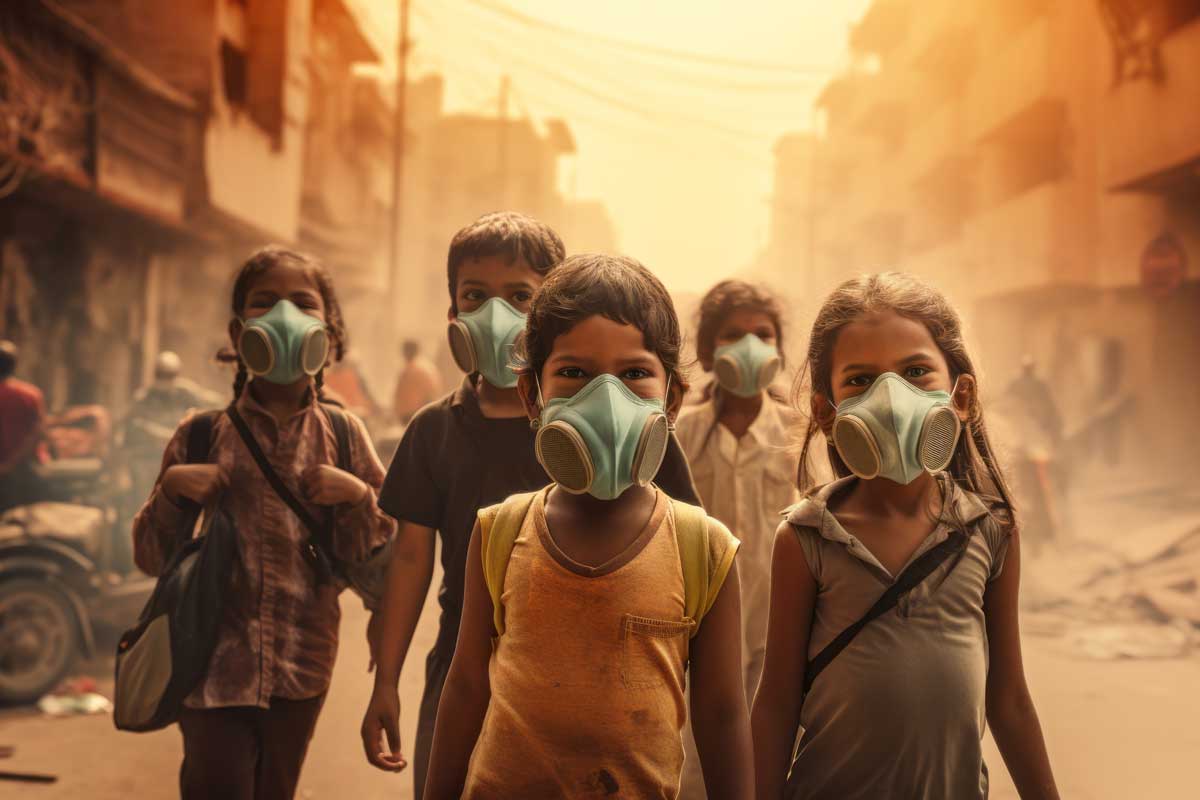In a shocker for Mumbaikars, who were under the impression that proximity to the sea would take care of any pollution, Mumbai’s Guardian Minister Deepak Kesarkar, citing data from the Central Pollution Control Board, said the city had an average air quality index (AQI) score of 156 while New Delhi was at 121. He attributed this to development projects such as the metro and real-estate construction. To curb pollution, Brihanmumbai Municipal Corporation (BMC) has warned that it will shut down construction sites that do not take pollution control measures.Currently, there are about 6,000 construction sites in Mumbai, including road infrastructure, metro-rail and other real-estate projects. Also, it is possible that construction activity has more than doubled on account of the 50 per cent premium (fees for approval) waiver announced by the Maharashtra government in 2021 In January 2021?, the state had approved a proposal to slash premium charges on real-estate projects by half until 31 December 2021.A vital factor that has contributed to the deteriorating air quality is the fact that the city has lost its green cover by 40 per cent between 1991 and 2022 and 30 per cent of its water bodies owing to rampant modernisation and construction activities. Over the past few years, a substantial number of trees, which play a vital role in mitigating air pollution by capturing suspended particulate matter, have been cut down to make way for real-estate and mega infrastructure projects.Vehicular emissions are also a significant contributor to Mumbai’s air pollution woes. Further, reports say refineries in the Chembur and Mahul areas are hotspots for air pollution. Besides, Deonar and Mankhurd have massive garbage dumps where people regularly burn garbage that lets out toxic fumes, polluting nearby areas.This deterioration in the city’s air quality did not happen overnight – it has been steadily increasing over the years. In fact, Mumbai’s air pollution increased by 60 per cent from 2019 to 2023 (See table).Air pollutionThe World Health Organisation (WHO) estimates that air pollution kills 4.2 million people around the world every year. About 56 per cent of occupational cancer in men is from within the construction industry. Also due to the scale of many construction projects, equipment is often running and polluting for a long time. Construction machines generate around 400 MT of CO2 emissions per year. In fact, the construction industry in the UK is responsible for the largest annual number of occupational cancer cases with around 8 per cent of these directly related to diesel engine exhaust emissions. Further, air pollution contributes significantly to global warming and, therefore, to climate change.Water pollutionConstruction activities often involve the use of contaminants in the form of toxic chemicals and pollutants, such as volatile organic compounds (VOCs), paints, glues, diesel, oils, other toxic chemicals and cement, which may end up in water bodies through drains, seep into soil or run off directly into rivers or lakes. Some VOCs, including benzene, can increase the risk of cancer if swallowed or breathed in large amounts over a long period of time. Pollutants from construction sites can soak into the groundwater. Many places use the dark murky water for drinking purposes and even crops get adversely affected. It is difficult to treat groundwater and chemical pollutants such as arsenic and mercury in drinking water can cause health issues, including cancer. Water contamination can also harm or kill fish and animals.Noise pollutionThe different types of heavy-duty machinery used in excavation, demolition, building and landscaping all contribute to noise pollution. The fact that we can’t ‘see, taste or smell’ sounds may explain why it has not received as much attention as other types of pollution. WHO reported an estimated 1 million healthy years of life lost every year from effects of environmental noise, including annoyance, sleep disturbance and ischemic heart disease.Industry speakOn the decision taken by the Government to ban construction and demolition activities in areas with severe air quality, Ankush Kaul, Chief Business Officer, Ambience Group, says, “We fully support the Government's initiative to pause construction activities in an effort to combat pollution. We understand that this decision is in the best interest of public health and environmental sustainability. While this temporary halt may pose challenges to our industry, we firmly believe in prioritising the well-being of our community. We are prepared to take all necessary steps to contribute to a cleaner, healthier Delhi NCR.”Meanwhile, Anuj Puri, Chairman, ANAROCK Group, says, “Amid Mumbai’s worsening air quality, BMC is mulling a halt of construction activities, particularly for those projects that do not adhere to proper dust and pollution control measures. If this continues, it will definitely affect the timely delivery of projects. As far as construction is concerned, our research indicates that there are currently as many as nearly 0.4 million housing units under various stages of construction in Mumbai alone. All these units have been launched in 2013 and beyond. On an average, a one-month ban on all construction activity delays a project by at least three to four months.”As for air monitoring measures to be carried out at construction and demolition sites, Dhaval Monani, Director, Affordable Housing, Anant National University, explains, “Construction sites emit many major pollutants, PM 10 and 2.5 being the major ones due to excavation, material handling and preparation. In addition, CO2, VOCs and NOx are produced because of burning of fuels and activities such as welding. PM monitoring sensors are the best indicators. Depending on site conditions and design, a minimum number should be made mandatory. Sensors to measure CO2, monoxide, volatile organic chemicals and nitrous oxide emissions – major soil pollutants and a cause of respiratory problems – are expensive and usually avoided. These monitors should be installed as the effects of these chemical pollutants last longer.”The global construction sector contributes to 23 per cent of air pollution, 40 per cent of drinking water pollution and 50 per cent of landfill waste. Queried about learnings from other countries in terms of pollution, he says, “Western countries have never had such a volume of construction as we see in India today. Europe extensively uses noise barriers and very high level of mechanisation and tight control over working hours. Water pollution has been the most difficult to tackle as it is difficult to assess. Europe has very stringent laws with random inspections that have proved most effective with builders or contractors taking proactive steps to reduce pollution.”About metro construction and real-estate projects, Monani says, “Mumbai is seeing AQI of over 240 in certain areas like BKC and South Mumbai, which are construction hotspots. The coastal road, metro works and roadworks are going on at an unprecedented pace, coinciding with a bull market in construction. Metro and road projects, in particular, contribute to much higher pollution as a very large amount of excavation needs to be done. The coastal road is along the western sea face and winds carry extra particulate pollution in certain areas. There are limited options for the Government. It cannot slow down metro or road construction nor can it put unreasonable demands on private developers. The only options are to spray water to keep particulate matter down and ensure that sand and aggregate are sprayed with water before they enter the air mist machines.”In terms of construction waste, the National Building Code (NBC) prescribes the manner in which it should be handled. A suggestion put forth by it mentions the promotion of use of agricultural and industrial waste, including construction and demolition waste in building construction, without compromising on the quality and safety.Also, construction and demolition businesses in the UK generated 67.8 MT of non-hazardous waste in 2018, of which the recovery rate was around 92.3 per cent. So what should be done for business houses in India to properly manage their construction waste? Monani says, “Indian waste is of very low quality. In construction and demolition waste, high-value items like steel, metal (wires and aluminium), wood and even plastics are usually completely salvaged. Even whole bricks are scavenged, cleaned and reused. Construction and demolition waste in India is virtually bricks, concrete and plaster. It can be converted into aggregate and sand. Recycled material is not financially viable under normal circumstances as in a majority of locations it is more expensive to process than virgin material and, in some ways, inferior in quality. There have to be incentives in place from the Government or a conscious effort from business houses to use construction waste for a significant portion of their needs.”Impact on construction workersThe construction sector is India's second-largest job generator after agriculture, employing an estimated 70 million people, including unskilled workers who leave the countryside for cities in the hope of better lives. A knee-jerk ban on construction activity affects daily-wage workers who cannot afford to sit at home or get ill, especially when jobs are scarce.The Delhi Government has at times given some compensation to construction workers when bans are enforced, but it was not done this year.The impact of pollution represents a heavy cost to the economy also. Lost labour income due to fatal illness from PM 2.5 pollution in 2017 was in the range of $ 30-78 billion, equal in magnitude to about 0.3-0.9 per cent of the country’s GDP. While cement accounts for an astounding 8 per cent of the world’s carbon dioxide emissions and pollution cannot be wished away, a ban on halting construction and allied infrastructure (metro, etc) activities in cities like Delhi affects daily wage workers for 10-15 days.“To address the economic impact of construction interruptions on wage workers, the Government has launched welfare and security initiatives,” says Kezya De Bragança, Founder & CEO, Bettamint. Both the Government and private sector must focus on enhancing awareness and literacy around these programmes, so that workers can access the necessary support. This collaboration is key to maintaining their livelihood during construction halts while relieving financial pressure on the private sector. In terms of health, beyond standard health checks and safety measures, construction workers need healthcare access that is both convenient and advanced.”As for measures to protect workers from pollution, she says, “Developed nations are pioneering the fight against pollution by adopting cutting-edge emission reduction techniques and incentivising the adoption of green technologies. Further, accessible healthcare technologies near worksites, combined with digital health monitoring and affordable credit, ensure workers' physical and financial well-being. In essence, innovative use of technology is central to developing sustainable construction practices that uphold environmental integrity and prioritise worker safety.”“It is imperative to administer regular air monitoring measures at construction sites to take care of the health of workers, site engineers and people living nearby,” affirms Saket Mohta, Managing Director, Merlin Group. About management of construction waste by business houses, Saket Mohta, MD, Merlin Group, advises, “Establish a waste management team; set targets for waste reduction; select waste management partners and set clear goals.”The way aheadWith 2023 poised to be the hottest year ever recorded, the UN Secretary General declared that this year marks the end of global warming and the onset of global boiling. Even the most developed nations are not immune with floods in New York and Dubai serving as a reminder that mere words and pledges won't thwart the destructive power of the climate crisis.The Government has strengthened emission standards. In 2020, it set aside about $ 1.7 billion to fight air pollution over the next five years for 42 Indian cities – provided they reduce their air pollution levels by 15 per cent every year. This is the world’s first performance-based fiscal transfer funding programme for air quality management in cities. Maharashtra too has earmarked 8 per cent of its total budget of Clean Air Funds, amounting to Rs.992.2 million out of Rs.12.4 billion, towards dust mitigation. It has also allotted 80 per cent of the funds (Rs.9.92 billion) towards electrification of Mumbai’s public transport system.Construction and demolition are a crucial part of development and cannot be banned. So business houses should prevent ‘cost-cutting’ activities and install emission control systems at construction sites to ensure particulate matter levels do not exceed prescribed limits.Studies show that continuous exposure to PM 2.5 pollutants has reduced the average lifespan of Mumbaikars by a few years, and tens of thousands of people die prematurely every year due to air pollution, but life goes on for the city’s residents. This ‘chalta hai’ mindset must change.Air quality management also needs to be integrated into the behaviour of individuals as part of nation building. In Beijing (once the global capital of air pollution), Paris, London and Los Angeles, the need to address air pollution found resonance among the people, which assumed political significance and led to ambitious policymaking. Thus, people’s initiatives forced political action. Improving air quality requires concerted and collective efforts, apart from political will to take tough measures. So from the simple habit of switching off the car or two-wheeler ignition at traffic signals that exceed 15 seconds, let us make the right (non-monetary) investments to create a better world for the next generation!-R Srinivasan


















